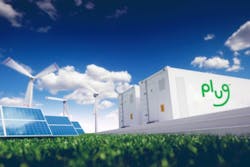Plug Power Installs Amazon’s First PEM Electrolyzer at Colorado Fulfillment Center to Produce Hydrogen for Forklifts
Plug Power Inc., a hydrogen fuel cell systems developer, has completed installing and commissioning an electrolyzer system at Amazon’s fulfillment center in Aurora, Colorado.
The 1 MW proton exchange membrane (PEM) electrolyzer is the first to be utilized at Amazon and is producing low-carbon hydrogen to fuel more than 225 hydrogen fuel-cell-powered forklift trucks at the fulfillment center.
“Hydrogen is an important tool in our efforts to decarbonize our operations by 2040 in support of The Climate Pledge, and we’re excited about our ability to produce hydrogen at Amazon facilities through this partnership with Plug,” said Asad Jafry, Director of Global Hydrogen Economy at Amazon. “On-site production will make the use of hydrogen even more energy efficient for certain locations and types of facilities.”
Plug Power has previously partnered with Amazon to deploy more than 17,000 fuel cells to replace traditional forklift batteries at over 80 fulfillment centers across North America.
What separates this project from previous collaborative efforts is that the hydrogen to power the forklifts has traditionally been produced elsewhere, liquified, and delivered by trucks to an on-site storage and dispensing system.
The electrolyzer works by using electricity and water to produce hydrogen, and Plug Power reports the system will be able to support up to 400 hydrogen fuel-cell-powered trucks. The hydrogen produced by the electrolyzer will be compressed on-site and stored in a gaseous hydrogen storage tank, which the forklift trucks can access and use.
For this project, Plug Power provided design, installation, commissioning, and maintenance services for the 1 MW proton exchange membrane electrolyzer and hydrogen storage, which are compatible with the existing refueling infrastructure and fuel cells already in use at the fulfillment center.
About the Author
Breanna Sandridge, Senior Editor
Breanna Sandridge is senior editor for EnergyTech and Microgrid Knowledge, both part of the energy group at Endeavor Business Media.
Prior to that, Breanna was managing editor for Machinery Lubrication and Reliable Plant magazines, both part of Noria Corp. She has two years experience covering the industrial sector.
She also is a 2021 graduate of Northeastern State University (Oklahoma) with a Bachelor's in English.
